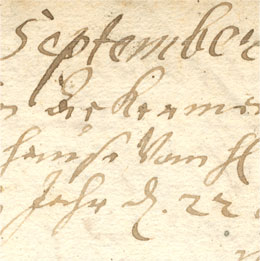Why is the small retable of Järva-Madise Church thought to be the work of Christian Ackermann?
At first glance the Järva-Madise Church retable differs from most of the retables made in Ackermann’s workshop, mainly in terms of its structure. It only has one level, it does not have any side figures and, in addition to the figures on the cornice, there is also luxuriant ornamental décor to be found there. However, if the structure of the Järva-Madise Church retable is analysed detail by detail, taking the carving style of its ornamentation into account, then there is no doubt – Christian Ackermann did fashion the carvings of the truly baroque retable in the medieval church of Järva-Madise. Based on the carving style of the statues and ornamentation, the retable dates from the first half of the 1690s.
Which details of the Järva-Madise Church retable are found in Ackermann’s other works and why?
Ackermann had previously used the same kind of putto corbel that can be seen on the cornice of the retable in Järva-Madise to decorate the Märjamaa Church retable (which has perished). Just as in Märjamaa, the statue of Christ the Invincible was placed on the putto corbel in Järva-Madise as well. Ackermann also carved similar statues for the retables in Tallinn’s Cathedral and Martna Church, as well as for the Karuse Church pulpit sounding board. Ackermann similarly used the flower bouquet motif on the retable’s side reliefs to decorate the Märjamaa Church retable.
What happened to the Järva-Madise retable after Ackermann?
Similarly to Ackermann’s other surviving retables and pulpits, the Järva-Madise Church retable has also been redesigned after the master artist’s death. The most significant change was made in 1866, when the original altar painting, which was on a wooden base, was replaced with the sentimental picture on a canvas base entitled “Christ on the Cross” and made by Theodor Albert Sprengel, the latter corresponding better with the taste of that time. At the same time, the altar painting was evidently raised higher with the help of a wooden construction that increased the entire height of the altar table. The retable was built on top of the old stone table of the altar.
The other key change was the repainting of the retable, which was originally painted with rich polychromy. Its ornamentation and the architectonic parts, excluding the columns, were coated with brown paint, while the columns and figures were painted over with white.
